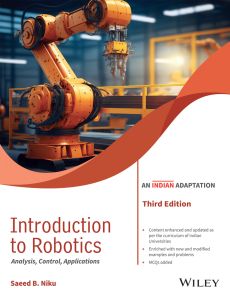Introduction to Robotics: Analysis, Control, Applications, 3ed (An Indian Adaptation)
ISBN: 9789357461306
520 pages
Publication Year: 2024
For more information write to us at: acadmktg@wiley.com

Description
Introduction to Robotics: Analysis, Control, Applications, third edition offers a guide to the fundamentals of robotics, robot components, and subsystems and applications. The author—a noted expert on the topic—covers the mechanics and kinematics of serial and parallel robots, both with the Denavit–Hartenberg approach and screw-based mechanics.
Preface to the Adapted Edition
Preface to the US Edition
1.1 Introduction
1.2 What Is a Robot?
1.3 Classification of Robots
1.4 What Is Robotics?
1.5 Evolution of Robots and Robotics
1.6 Robot Components
1.7 Robot Degrees of Freedom
1.8 Robot Joints
1.9 Robot Coordinates
1.10 Robot Reference Frames
1.11 Robot Characteristics
1.12 Robot Workspace
1.13 Robot Applications
1.14 Programming Modes
1.15 Robot Languages
1.16 Advantages and Disadvantages of Robots
1.17 Other Robots and Applications
1.18 Collaborative Robots
1.19 Social Issues
1.20 Summary
2 Kinematics of Serial Robots: Position Analysis
2.1 Introduction
2.2 Robots as Mechanisms
2.3 Conventions
2.4 Matrix Representation
2.5 Homogeneous Transformation Matrices
2.6 Representation of Transformations
2.7 Inverse of Transformation Matrices
2.8 Forward and Inverse Kinematics of Robots
2.9 Forward and Inverse Kinematic Equations: Position
2.10 Forward and Inverse Kinematic Equations: Orientation
2.11 Forward and Inverse Kinematic Equations: Position and Orientation
2.12 Denavit-Hartenberg Representation of Forward Kinematic Equations of Robots
2.13 The Inverse Kinematic Solution of Robots
2.14 Inverse Kinematic Programming of Robots
2.15 Dual-Arm Cooperating Robots
2.16 Degeneracy and Dexterity
2.17 The Fundamental Problem with the Denavit-Hartenberg Representation
2.18 Design Projects
2.19 Summary
3 Robot Kinematics with Screw-Based Mechanics
3.1 Introduction
3.2 What Is a Screw?
3.3 Rotation about a Screw Axis
3.4 Homogenous Transformations about a General Screw Axis
3.5 Successive Screw-Based Transformations
3.6 Forward and Inverse Position Analysis of an Articulated Robot
3.7 Design Projects
3.8 Summary
4 Kinematics Analysis of Parallel Robots
4.1 Introduction
4.2 Physical Characteristics of Parallel Robots
4.3 The Denavit-Hartenberg Approach vs. the Direct Kinematic Approach
4.4 Forward and Inverse Kinematics of Planar Parallel Robots
4.5 Forward and Inverse Kinematics of Spatial Parallel Robots
4.6 Other Parallel Robot Configurations
4.7 Design Projects
4.8 Summary
5 Differential Motions and Velocities
5.1 Introduction
5.2 Differential Relationships
5.3 The Jacobian
5.4 Differential versus Large-Scale Motions
5.5 Singularities
5.6 Differential Motions of a Frame versus a Robot
5.7 Differential Motions of a Frame
5.8 Interpretation of the Differential Change
5.9 Differential Changes Between Frames
5.10 Differential Motions of a Robot and Its Hand Frame
5.11 Calculation of the Jacobian
5.12 How to Relate the Jacobian and the Differential Operator
5.13 The Inverse Jacobian
5.14 Calculation of the Jacobian with Screw-Based Mechanics
5.15 The Inverse Jacobian for the Screw-Based Method
5.16 Calculation of the Jacobians of Parallel Robots
5.17 Design Projects
5.18 Summary
6 Dynamic and Force Analysis
6.1 Introduction
6.2 Lagrangian Mechanics: A Short Overview
6.3 Effective Moments of Inertia
6.4 Dynamic Equations for Multiple-DOF Robots
6.5 Static Force Analysis of Robots
6.6 Transformation of Forces and Moments between Coordinate Frames
6.7 Design Project
6.8 Summary
7 Trajectory Planning
7.1 Introduction
7.2 Path vs. Trajectory
7.3 Joint-Space vs. Cartesian-Space Descriptions
7.4 Basics of Trajectory Planning
7.5 Joint-Space Trajectory Planning
7.6 Cartesian-Space Trajectories
7.7 Continuous Trajectory Recording
7.8 Design Project
7.9 Path Planning
7.10 Summary
8 Motion Control Systems
8.1 Introduction
8.2 Basic Components and Terminology
8.3 Block Diagrams
8.4 System Dynamics
8.5 Laplace Transform
8.6 Inverse Laplace Transform
8.7 Transfer Functions
8.8 Block Diagram Algebra
8.9 Characteristics of First-Order Transfer Functions
8.10 Characteristics of Second-Order Transfer Functions
8.11 Characteristic Equation: Pole/Zero Mapping
8.12 Steady-State Erro
8.13 Root Locus Method
8.14 Proportional Controllers
8.15 Proportional-Plus-Integral Controllers
8.16 Proportional-Plus-Derivative Controllers
8.17 Proportional-Integral-Derivative Controller (PID)
8.18 Lead and Lag Compensators
8.19 Bode Diagram and Frequency-Domain Analysis
8.20 Open-Loop vs. Closed-Loop Applications
8.21 Multiple-Input and Multiple-Output Systems
8.22 State-Space Control Methodology
8.23 Digital Control
8.24 Nonlinear Control Systems
8.25 Electromechanical Systems Dynamics: Robot Actuation and Control
8.26 Design Projects
8.27 Summary
9 Actuators and Drive Systems
9.1 Introduction
9.2 Characteristics of Actuating Systems
9.3 Comparison of Actuating Systems
9.4 Hydraulic Actuators
9.5 Pneumatic Devices
9.6 Electric Motors
9.7 Microprocessor Control of Electric Motors
9.8 Magneto strictive Actuators
9.9 Shape-Memory Type Metals
9.10 Electroactive Polymer Actuators (EAPs)
9.11 Speed Reduction
9.12 Selection of Actuators – Case Studies
9.13 Other Systems
9.14 Design Projects
9.15 Summary
10 Sensors
10.1 Introduction
10.2 Sensor Characteristics
10.3 Sensor Utilization
10.4 Classification of Sensors
10.5 Position Sensors
10.6 Velocity Sensors
10.7 Acceleration Sensors
10.8 Force and Pressure Sensors
10.9 Torque Sensors
10.10 Microswitches
10.11 Visible Light and Infrared Sensors
10.12 Touch and Tactile Sensors
10.13 Proximity Sensors
10.14 Range Finders
10.15 Sniff Sensors
10.16 Vision Systems
10.17 Voice-Recognition Devices
10.18 Voice Synthesizers
10.19 Remote Center Compliance (RCC) Device
10.20 Design Project
10.21 Selection of Sensors – Case Study
10.22 Summary
11 Image Processing and Analysis with Vision Systems
11.1 Introduction
11.2 Basic Concepts
11.3 Fourier Transform and Frequency Content of a Signal
11.4 Frequency Content of an Image: Noise and Edges
11.5 Resolution and Quantization
11.6 Sampling Theorem
11.7 Image-Processing Techniques
11.8 Histograms of Images
11.9 Thresholding
11.10 Spatial Domain Operations: Convolution Mask
11.11 Connectivity
11.12 Noise Reduction
11.13 Edge Detection
11.14 Sharpening an Image
11.15 Hough Transform
11.16 Segmentation
11.17 Segmentation by Region Growing and Region Splitting
11.18 Binary Morphology Operations
11.20 Image Analysis
11.21 Object Recognition by Features
11.22 Depth Measurement with Vision Systems
11.23 Specialized Lighting
11.24 Image Data Compression
11.25 Color Images
11.26 Heuristics
11.27 Applications of Vision Systems
11.28 Design Project
11.29 Summary
12 Fuzzy Logic Control
12.1 Introduction
12.2 Fuzzy Control: What Is Needed
12.3 Crisp Values vs. Fuzzy Values
12.4 Fuzzy Sets: Degrees of Truth and Membership
12.5 Fuzzification
12.6 Fuzzy Inference Rules
12.7 Defuzzification
12.8 Simulation of a Fuzzy Logic Controller
12.9 Applications of Fuzzy Logic in Robotics
12.10 Genetic Algorithms
12.11 Artificial Neural Networks (ANNs)
12.12 Internet of Robotic Things (IoRT)
12.13 Design Project
12.14 Summary
References
Problems
Multiple-Choice Questions
Answer Key
Appendix A
Appendix B
Index

